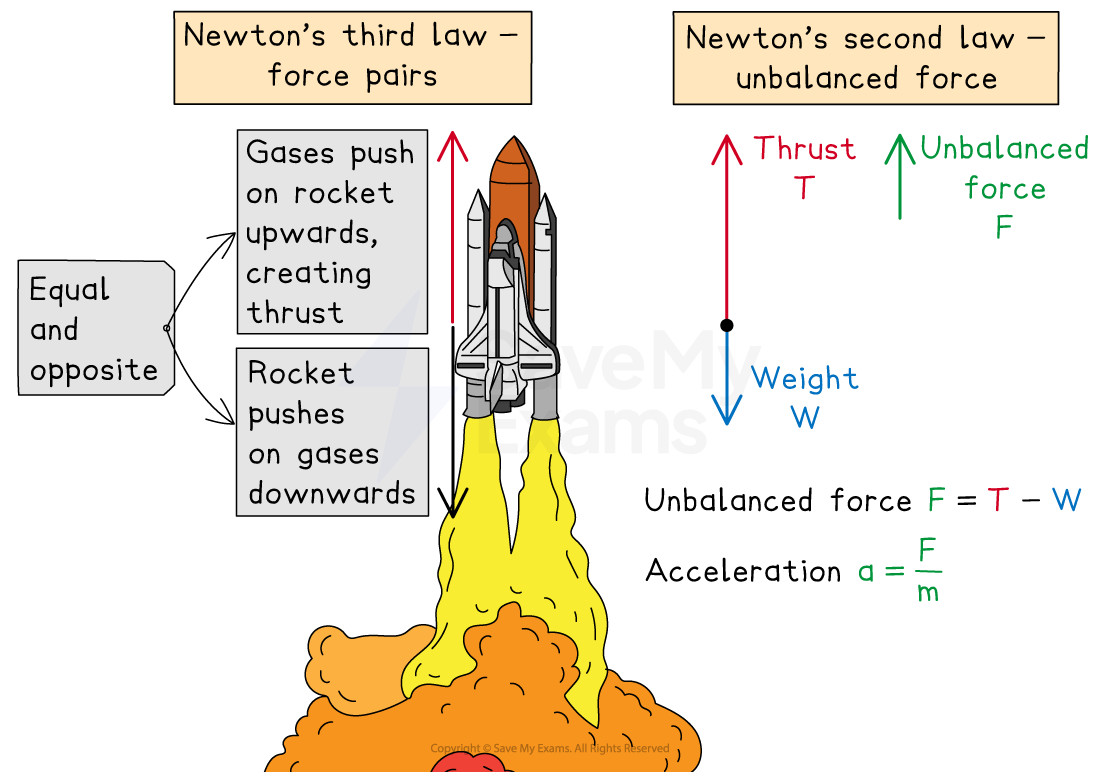Newton’s Laws & Space Travel (SQA National 5 Physics): Revision Note
Exam code: X857 75
Newton’s laws & space travel
Newton's laws can be applied to space travel, including the launch and landing of a rocket
Newton's third law states:
If object A exerts a force on object B, then object B exerts an equal and opposite force on object A
Newton's second law states:
The acceleration of an object is proportional to the unbalanced force acting on it and inversely proportional to the object's mass
Newton's first law states:
An object will remain at rest or continue to move with constant velocity unless acted on by an unbalanced force
Rocket launch
Newton's third law during launch
When rocket fuel burns, exhaust gases are expelled downwards at high speed
The rocket exerts a force on the gases, so according to Newton's third law, the gases must exert an equal but opposite force on the rocket
As the gases push back on the rocket, this provides the thrust which propels it upwards
Newton's second law during launch
During lift-off, the forces acting on the rocket are
Thrust acting upward
Weight acting downward
The rocket’s thrust
must exceed its weight
to achieve lift-off
This produces an unbalanced force equal to:
According to Newton's second law, the unbalanced force
causes the rocket to accelerate upwards
Where:
= acceleration of the rocket, measured in metres per second squared (m s-2)
= unbalanced force on the rocket, measured in newtons (N)
= mass of the rocket, measured in kilograms (kg)
As the altitude increases, the acceleration of the rocket increases
This is because the unbalanced force on the rocket increases as the weight of the rocket decreases
There are several reasons for this:
The mass of the rocket decreases as it burns fuel
When the fuel is used up, the fuel tank is released, so the mass decreases even further
Gravitational field strength decreases with distance from the surface
Applying Newton's laws to a rocket launch

Space travel
Newton's first law during space travel
Once free of Earth’s atmosphere, a spacecraft no longer needs continuous thrust because there is no friction to oppose its motion
It continues moving at constant velocity until acted upon by another unbalanced force
Newton's third law during space travel
Newton's third law also explains how ion propulsion works
The ejection of ions in one direction causes the spacecraft to move in the opposite direction
This provides a small, unbalanced force which allows spacecraft to
achieve a high velocity when applied over an extended period of time
perform precise manoeuvres in zero-friction environments, such as docking with the ISS
Rocket landing
The same principles applied to launching a rocket can also be applied to landing a rocket
Newton's third law during landing
During landing, the spacecraft expels exhaust gases, producing a downward force on the gases
The gases push back on the spacecraft, providing an equal upward force
This produces a thrust which slows the descent of the spacecraft
Newton's second law during landing
During launch, the rocket is stationary, so it has a velocity of zero
So, when the unbalanced force is applied, it causes the rocket to accelerate
Whereas, during landing, the spacecraft has a downward velocity that it is trying to reduce to zero
Therefore, the same unbalanced force is required to cause it to decelerate
i.e. the rocket’s thrust
must exceed its weight
to slow its descent
Some spacecraft deploy parachutes to reduce the unbalanced force and land at a lower terminal velocity

Unlock more, it's free!
Did this page help you?